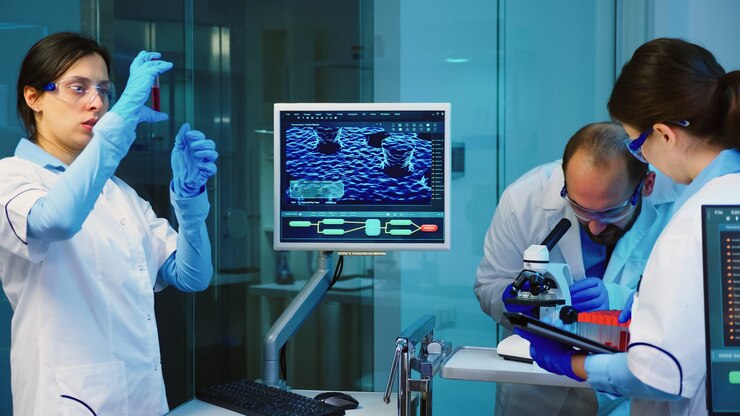SDS-PAGE Electrophoresis, a fundamental technique in biochemistry and molecular biology, plays a pivotal role in separating proteins based on their molecular weight. Provided by Kendrick Labs, this article delves into the techniques and applications of SDS-PAGE Electrophoresis, offering a comprehensive understanding of its principles and practical aspects. From the basic principles of protein separation to advanced applications and troubleshooting tips, this article serves as a valuable resource for researchers and scientists seeking to harness the power of SDS-PAGE in their analytical and research endeavors.
Introduction to SDS-PAGE Electrophoresis
If you’ve ever wondered how scientists separate and analyze proteins, SDS-PAGE (Sodium Dodecyl Sulfate-Polyacrylamide Gel Electrophoresis) is your answer. This powerful technique uses the magic of electricity to put proteins in their place. Let’s dive into the world of electrophoresis and see how Kendrick Labs is shaking things up.
Overview of Electrophoresis
Imagine a microscopic marathon where proteins compete to reach the finish line based on their size and charge – that’s electrophoresis in a nutshell. By subjecting the proteins to an electric field, they obediently move through a gel matrix at different speeds, allowing us to separate and study them in detail.
Role of SDS-PAGE in Protein Analysis
Enter SDS-PAGE, the superhero of protein analysis. By coating proteins with SDS, a detergent that makes them shed their 3D shapes and cling to a negative charge, we level the playing field based on size alone. This lets us unravel the mysteries of protein structure and composition like never before.
Principles of SDS-PAGE Electrophoresis
Ready to unravel the magic behind SDS-PAGE electrophoresis? Strap in as we explore the inner workings of this technique that has revolutionized protein analysis.
Function of SDS and PAGE in SDS-PAGE
SDS plays the role of the strict parent, coating proteins with a negative charge and denaturing them into linear blobs. The PAGE gel then acts as a molecular obstacle course, slowing down these proteins based on size as they journey through it, revealing their true identities.
Mechanism of Protein Separation in SDS-PAGE
As the proteins enter the gel matrix, smaller proteins breeze through like sprinters, while larger ones lag behind like marathon runners. This separation based on size gives us a beautiful protein fingerprint that helps us understand their functions and interactions better.
Techniques for Running SDS-PAGE Gels
Running an SDS-PAGE gel is a bit like preparing a delicate scientific recipe – precision is key. Let’s uncover the steps involved in setting up and loading an SDS-PAGE gel like a pro.
Preparation of SDS-PAGE Gel Components
Gathering the ingredients for an SDS-PAGE gel is like prepping for a culinary masterpiece. Mixing acrylamide, bis-acrylamide, buffer solutions, and catalysts, you create the perfect environment for your proteins to strut their stuff during electrophoresis.
Assembly and Loading of SDS-PAGE Gel
Like building a tiny protein racetrack, pouring the gel mixture between glass plates and inserting comb-like spacers sets the stage for protein separation. Carefully loading your protein samples into the wells with precision ensures a successful electrophoretic adventure.
Protein Separation and Visualization in SDS-PAGE
It’s time for the big reveal – watching your proteins separate and come to life in the gel matrix is like witnessing a scientific masterpiece unfold.
Running SDS-PAGE and Staining Protocols
Once the electric current is applied, sit back and watch the proteins embark on their gel journey. After the separation is complete, staining the proteins with special dyes highlights their presence, turning a bland gel into a vibrant canvas of protein bands waiting to be analyzed.
Image Analysis and Data Interpretation
Capturing the stained gel image and analyzing the protein bands is where the real detective work begins. By comparing the band sizes and intensities, scientists can unlock valuable information about protein composition, purity, and even study changes under different experimental conditions.
Applications of SDS-PAGE Electrophoresis in Research
When it comes to diving into the microcosm of proteins for research purposes, SDS-PAGE Electrophoresis is a trusty sidekick. One of its nifty tricks is the characterization of protein samples, giving scientists a closer look at the makeup of proteins present in a sample. Additionally, SDS-PAGE Electrophoresis can unravel the tangled web of protein complexes and interactions, shedding light on how these biomolecular relationships function in the grand scheme of things.
Quality Control and Troubleshooting in SDS-PAGE
Even the best of us stumble sometimes, and SDS-PAGE Electrophoresis is no exception. Common issues like wonky bands or weird patterns can throw a wrench in the works, but fear not! Solutions are at hand to tackle these hiccups head-on. Moreover, validation and quality assurance play crucial roles in ensuring that the results obtained through electrophoresis are as reliable as your favorite pair of sweatpants.
Advanced Applications and Variants of SDS-PAGE
Ready to level up your electrophoresis game? Enter Two-Dimensional Gel Electrophoresis (2D-PAGE), a technique that takes SDS-PAGE to the next dimension (literally). By allowing the separation of proteins based on their isoelectric point and molecular weight, 2D-PAGE offers a more nuanced view of the protein landscape. And let’s not forget the dynamic duo of Western Blotting and Immunoblot Analysis, which team up with SDS-PAGE to detect specific proteins with the finesse of a detective solving a mystery.
Future Directions in SDS-PAGE Electrophoresis
As we bid adieu to this whirlwind tour of SDS-PAGE Electrophoresis, it’s clear that this technique has left an indelible mark in the realm of protein analysis. With advancements in technology and methodology, the future of SDS-PAGE holds exciting prospects, promising even deeper insights into the intricate world of proteins. So, buckle up and get ready for the next chapter in the electrifying saga of SDS-PAGE Electrophoresis!
Conclusion
SDS-PAGE Electrophoresis stands as a cornerstone technique in protein analysis, offering researchers a powerful tool for studying protein structure, function, and interactions. With its versatility and robust applications, SDS-PAGE continues to drive advancements in diverse fields of biological research. As we look towards the future, the potential for further innovations and refinements in SDS-PAGE techniques promise to enhance our understanding of the complex world of proteins.

